Restorative and nourishing, Bone Broth is everywhere these days- and understandably so! It’s affordable, packed with age-defying collagen, and easy to make right at home in either your Instant Pot, slow cooker, or in a stockpot on the stove. Learn How to Make Beef Bone Broth with my easy-to-follow instructions, tips, and answers to all your bone broth frequently asked questions.
What is Bone Broth?
Bone Broth is a savory, nutrient-dense, and collagen-rich liquid made from simmering marrow-rich animal bones (beef, chicken, turkey, pork) in water for an extended period of time. In addition to bones and connective tissue, vegetables like celery, carrots, and onions, fresh herbs, and garlic for extra flavor.
Since bone broth is often graded by how gelatinous it is upon cooling, sometimes apple cider vinegar or white vinegar is added in small amounts to help break down the animal proteins and connective tissues. This aided breakdown helps provide a broth higher in protein and collagen.
How is Bone Broth Different From Regular Broth or Stock?
Technically there isn’t a clear hard line separating one from the other, but there are a few differences.
Totally confused? Let me try to clarify.
Bone broth: Beautiful, golden, and super-flavorful. Bone broth is made by simmering bones (specifically those high in collagen) for longer periods of time (often 12-hours on the stovetop) or pressure cooker for at least 3-4 hours. Once cooled, bone broth will usually firm-up into a jelly-like consistency due to its high gelatin content.
Regular Stock: Depending on the type of bones used, regular stock can be quite gelatinous after cooking. It typically simmered for longer periods of time compared to regular broth. Homemade chicken stock, as an example, can bee made using an entire, uncooked, whole chicken or just the remaining chicken carcass.
Regular Broth: Typically thinner as it contains much less, if any, collagen. Regular Broth is made from boiling actual meat, and less from marrow-rich bones. For example, after poaching chicken the resulting liquid is considered chicken broth.
So, if you’re wondering which of the three will give you the most collagen-rich and nutrient-dense broth, the winner is bone broth, hands down.
When prepared correctly, of course.
What are the Benefits of Bone Broth?
With its sudden rise in popularity, there has been a nonstop buzz all about the miracle health benefits of bone broth. We already know it to be a nutrient-rich liquid made by simmering animal bones (cow, chicken, pork bones, and sometimes fish bones) and connective tissue in water over a long period of time. But it is also believed that drinking bone broth is beneficial to our joints, digestive system, and skin as it contains many important minerals and nutrients.
While there is plenty of evidence to suggest these benefits to be true, there is no published research confirming, with absolute certainty that this is the case. Full disclosure.
6 (possible) benefits of drinking bone broth
- Bone broth is highly nutritious. As a total package, bone broth is rich with vitamins and nutrients such as calcium, magnesium, and phosphorous. The total amount will vary depending on the type of animal source and bones you use, but in general, you’ll find loads of calcium, magnesium, potassium, and phosphorus, Vitamin A, K2, and minerals like zinc, iron, boron, manganese, and selenium in any given batch of quality bone broth recipe.
- It may protect the joints. Tissues and bones contain collagen. When cooked, collagen turns into gelatin. This gelatin – liquid (when heated), thick and jelly-like (when chilled) – is filled with amino acids, the building blocks of proteins. Glucosamine and chondroitin, in particular, are thought to reduce the symptoms of osteoarthritis (source 1, 2) and reduce joint pain.
- It may aid in digestion. Especially for people with inflammatory bowel disease or leaky gut syndrome according to this article which explains that specific amino acids may decrease the duration of active disease and contribute to the maintenance of IBD remission.
- May lead to better night sleep. According to Neuropsychopharmacology, Glycine, a non-essential amino acid found in bone broth, like this Instant Pot bone broth recipe, may improve sleep quality. Of course, more research is needed.
- Claims that it may help you lose weight. Since bone broth is a rich source of protein some like to claim that it will help you feel fuller, longer, and therefore help you lose weight. I know that for me personally a cup of bone broth would never fill me up so I’m highly suspicious about this one.
- Suggested to help fight inflammation. The amino acids glycine and arginine have strong anti-inflammatory effects. Arginine, in particular, may help fight inflammation associated with obesity in women (source). Chronic inflammation may lead to a number of serious diseases such as heart disease, diabetes, metabolic syndrome, arthritis, and types of cancer.
Ingredients in Homemade Bone Broth
- Beef bones
- Carrots
- Onions
- Celery
- Garlic
- Bay leaves
- Whole black peppercorns
- Whole star anise
- Cinnamon sticks
- Apple cider vinegar
If possible, try to purchase organic grass-fed beef bones. This guarantees a broth free of added hormones and antibiotics.
Equipment needed to make stock at home
You don’t need a ton of fancy equipment to make homemade broth. However, you will need a few essentials including,
- Stockpot– you will need at least two 8-quart stockpots to prepare this particular recipe.
- Roasting Pans or lined baking sheets – Because yes, for the best possible broth, you need to roast the bones before you boil them.
- Wire mesh strainer– inexpensive but completely necessary, you need a wire mesh strainer to strain the delicious broth from the bones and vegetables.
What are the Best Bones for Bone Broth?
In this particular beef bone broth recipe, I have added a mixture of knucklebones, short ribs, oxtail, and femur bones. The result was a delicious, nutrient-filled, gelatin-rich broth.
The best bones for the best bone broth (beef or chicken bone broth) include:
- Knuckles
- Joints
- Feet
- Marrow bones
- For added flavor incorporate meaty bones like oxtail, shank, and short ribs.
- Chicken feet (not included in this recipe) contain loads of gelatin and are less expensive than other gelatin-rich bones.
- The bones of younger animals contain a lot of cartilage, as it is this cartilage that will eventually turn to the bone as the animal ages. For this reason, veal bones are particularly prized for making stock (but I can’t do veal, so no veal bones in this soup).
Tip – If you’re unsure at all, ask the local butcher at your favorite grocery store for the best broth bones and then request that he or she cut them in half for you. Trust me, you do not want to bring home an entire femur – it won’t fit in your pot.
How to make bone broth
Although most major grocery stores carry bone broth, the cost of this convenience comes with a hefty price – around $5-6 a quart. Fortunately, making homemade broth at home is both easy and affordable.
Plan to start your broth in the morning, giving your bones at least 8-12 hours to simmer over low heat. If you prefer to make it using your Instant Pot or pressure cooker, check out my post dedicated just to that, How to Make Instant Pot Bone Broth.
Ok, let’s get started.
Step 1: Blanch the Bones
Divide the bones between two large pots and cover with cold water. Bring to a boil over high heat and simmer for 10-15 minutes before draining and rinsing the bones with water.
Do you have to blanch the bones? The answer is no. However, I recommend, especially if you’re making broth from beef bones, that you do blanch them first. If you’re using chicken bones or chicken feet blanching is less important, but beef bones really need this extra step, especially if you want a clear stock.
What’s the purpose of blanching? The purpose is to remove impurities, coagulated protein, and blood which ultimately results in a cleaner, better tasting broth.
As far as nutrient loss due to blanching? The nutrient loss is too small to justify not blanching (in my opinion).
Step 2: Roast the Bones and Vegetables
Now that your bones have been blanched, drained, and rinsed, it’s time to preheat your oven to 450 degrees F. Transfer the bones and vegetables (carrots, onions, garlic, celery) to the roasting pans. Avoid piling them all on top of each other- use two roasting pans, if necessary. Roast for 30 minutes before gently tossing the bones and vegetables, and roasting for an additional 15-30 minutes more.
Why roast bones for broth? Roasting equals flavor! And we love a little added flavor, right? This step in an easy way to brown and caramelize your bones without a lot of added work. Do you want to char or burn your bones? No. But, nice, deep browning? Yes.
Step 3: Transfer the Bones Back to the Stockpots & Bring to a Boil
Wash the stockpots that were used to blanch the bones (this is super important) and divide the roasted bones and vegetables between the two pots. Scrape up any brown bits and juices remaining in the roasting pan using a metal spatula and a little water, if needed, and divide between the two pots (don’t worry, all those brown bits are FLAVOR!).
With the bones and vegetables divided, divide the bay leaves, peppercorns, star anise, cinnamon sticks, and apple cider vinegar between the two pots.
Fill each pot with approximately 12 cups of cold water, or enough water to cover the bones by approximately an inch.
Cover each pot with a tight-fitting lid and bring to a low boil.
Can you cook your broth in a slow cooker (Crockpot)?
Yes. Absolutely. For this recipe, you will likely need 2 large slow cookers. Instead of transferring the roasted bones, veggies, herbs, and spices to large stockpots divide them among two (or three) slow cookers, cover with cold water, and cook on low for 24-48 hours with the lid slightly ajar. Add additional water, as needed, to keep the bones covered.
Step 4: Simmer
Reduce heat to low and simmer, with the lid slightly ajar, skimming any foam or excess fat, as needed. Simmer for at least 8-12 hours or up to 24 hours (do not leave the stove running overnight. Simply cool and store in the refrigerator and continue to simmer the next day). Add more water if needed to make sure bones and vegetables remain fully submerged.
- If the vegetables (particularly the carrots) turn too soft and mushy at any point throughout cooking, use a slotted spoon to remove. Enjoy as a delicious snack or discard.
Step 5: Strain the Bones
Once the bones have simmered and your broth is ready, you will need to strain the broth through a fine-mesh strainer. For an extra clear broth, strain a second time through a food-grade cheesecloth.
Set aside the broth to cool and allow the bones to cool (see more on storage and cooling below).
Step 6: Don’t Forget About the Meat
Depending on the type of bones you use to make your bone broth, you may or may not have any meat left to be picked off. In my case, I had tons of leftover delicious meat perfect for soup, sandwiches, or (if you’re not into the meaty bits) the family pet. Don’t let it go to waste! As for the vegetables, blend them together and add them to cooked rice, mashed potatoes, or, add a little broth and make it a delicious blended soup.
Step 7: Skim the Fat from Your Broth (optional)
Add a couple of handfuls of ice to your broth to expedite cooling and cover with a lid. Transfer your broth to the refrigerator and allow it to cool completely. The result will be a hard, thick layer of fat and a bottom layer that is your bone broth (which should look like gelatinous brown jello). If desired use a fork to scoop off the top layer of fat. This will leave behind the healthy bone broth, minus the fat.
Step 8: Store your bone broth
Bone broth stores well in the refrigerator for approximately 5 days. If you make a large batch, I recommend freezing smaller batches in the freezer for up to 6 months (it reheats perfectly!)
Tips and Tricks
- Use a mixture of different beef bones. Not all bones are created equal, as such, try to use 2-3 different types of bones to make your broth.
- Don’t forget to blanch the beef bones before roasting. Guys, this step is SO IMPORTANT. Blanching the bones for 15-20 minutes helps remove all those nasty bits that, well, make your bone broth look and taste kinda gross. These nasty parts won’t hurt you, but in order to achieve the beautiful, clear, rich bone stock, you need to blanch the bones.
- Roast your bones. Roast them high and roast them long. Roasting the beef bones browns and caramelizes them. This translates to more flavor. Who doesn’t want more flavor?
- Avoid the temptation to add too much “other stuff”. You are making bone broth NOT bone/vegetable/herb garden broth. This is not to say that you shouldn’t add any roasted veggies or spices, but keep it at a minimum so that the beef bones can really shine.
- If one stockpot isn’t big enough, use two. Your beef bones want to be fully submerged in water. If your pot isn’t big enough, use two.
- Allow enough time for the bones to simmer. You guys, a few hours is not enough time. I allowed this pot of beef bones to simmer for 14 hours and it turned out just perfect. Patience is key. With that said, longer is not always better. There is no need to simmer your bones for any longer than 24 hours.
- Refrigerate the soup overnight and remove the fat layer from the top. Of course, you don’t have to do this. Or you can do this and leave some of the fat. No matter what you decide, once the broth is reheated, it will all dissolve back into the smooth, beautiful delicious broth you started with.
- Add salt to taste. If you’re expecting your bone broth to taste identical to your favorite Vietnamese bowl of Pho without adding any salt then I am sorry to say you will be very disappointed. You will need salt. Exactly how much depends entirely on you.
How to Store Bone Broth
Let’s discuss storage and freezing.
I like to store my broth in sealed jars or freezer-safe bags ziplock bags. These are my favorite glass storage jars to use when freezing. They’re tall and skinny and great for deep freezers. When storing in the refrigerator, however, I usually keep leftovers in a pot with a lid as it is so much easier to reheat.
How long will leftover bone broth last?
Broth stored in the refrigerator will keep for 4-6 days while broth stored in the freezer will keep for at least 4-6 months.
Before storing or freezing always…
Before storing it’s super important to cool your broth to room temperature. Ideally, you want to do this as quickly as possible to prevent any chance of contamination. The easiest way to do this is by adding a couple of handfuls of ice to the pot, covering, and waiting for the broth to cool. The ice will help expedite this process.
Or, as suggested by a reader, fill your sink or bathtub with a few inches of cold water. Place the pot in the cold water and allow the broth to cool to room temperature.
How to Use All That Broth
Your reasons for making bone broth will likely determine how you serve it. For restorative and medicinal purposes, it is hugely popular to sip a cup of warm bone broth with a sprinkle of sea salt and cracked pepper.
If you’re not really interested in drinking your broth, use it the same way you would regular meat stocks or broths.
- Use it to make soups and stews, including bok choy soup, Vietnamese pho, chicken and wild rice soup, and beef stew.
- Use it to cook rice and grains like brown rice, risotto, wild rice, farro, lentils, and quinoa. Swapping water for bone broth is an easy way to add extra flavor and protein.
- Use it to make delicious sauces like gravy, roux, pan sauces, or reductions.
- Other delicious recipes include jambalaya, beef stroganoff, and tater tot casserole.
How Much Bone Broth Can I Drink Each Day?
A lot of you have asked how much broth you can (or should) drink each day. The truth is that I am not a doctor. So, if you’re drinking bone broth for medicinal reasons at all, I highly recommend consulting your doctor.
For anyone looking to include bone broth as part of an already balanced and healthy diet and lifestyle, enjoy anywhere from 2-4 cups daily.
Bone broth is not suitable for vegetarians, vegans, or anyone following a low-protein diet. It is wonderful, however, for those looking to include more protein as it is paleo and keto-approved, gluten-free, and dairy-free.
More Easy Recipes,
If you try making this Homemade Bone Broth Recipe, please leave me a comment and let me know! I always love to hear your thoughts.
RECIPE CARD
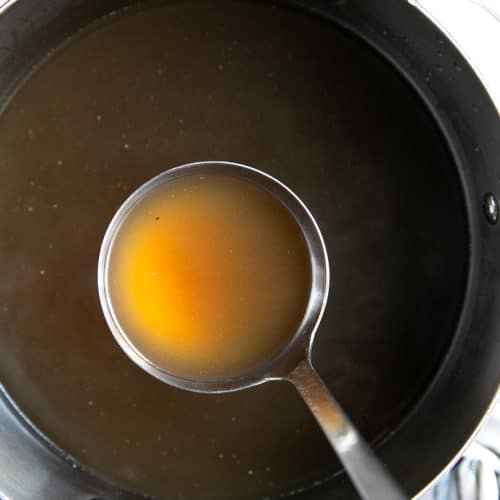
Bone Broth Recipe (How to Make Bone Broth)
Ingredients
- 10 pounds beef bones - preferably a mix of marrow bones (femur bones) and bones with meat on them (oxtail, short ribs, and knucklebones cut in half)*
- 4 large carrots - chopped into 2-inch pieces
- 2 medium onions - quartered
- 2 whole heads garlic - halved crosswise
- 6 stalks celery - cut into 2-inch pieces
- 4 bay leaves
- ¼ cup black peppercorns
- 4 whole star anise
- 2 whole cinnamon sticks
- 2 tablespoon apple cider vinegar
Instructions
- Blanch the bones. Divide the bones between two large stockpots and cover with cold water. Bring to a boil over high heat and simmer for 15-20 minutes before draining and rinsing the bones with water.
- Roast the bones and the vegetables. Ok, so the bones have been blanched. Now, preheat the oven to 450 degrees F. Transfer the bones and vegetables (carrots, onions, garlic, celery) to the roasting pans. Don't pile them all on top of each other- use two roasting pans. Roast for 30 minutes before gently tossing the bones and vegetables, and roasting for an additional 15-30 minutes more.
- Transfer the bones and vegetables back to the stockpots. But not before washing the stockpots first. Make sure you wash your pots after the bones were blanched and drained. Transfer the bones and vegetables back to the stock pots and scrape up any remaining bits and juices remaining in the roasting pan using a metal spatula and a little water, if needed. Transfer to the pot with the bones (don't worry, all those brown bits are FLAVOR!).
- Boil the bones. With the bones and vegetables divided between the two pots divide the bay leaves, peppercorns, star anise, cinnamon sticks, and apple cider vinegar between the two pots. Fill each pot with approximately 12 cups water, or until bones are fully submerged. Cover the pots and bring to a low and gently boil.
- Simmer the bones. Reduce heat to low and simmer, with the lid slightly ajar, skimming any foam or excess fat, occasionally. Simmer for at least 8-12 hours, ideally 24 hours (do not leave the stove running overnight. Simply cool and store in the refrigerator and continue to simmer the next day). Add more water if needed to make sure bones and vegetables remain fully submerged.
- Strain the bones. Once the bones have simmered and your broth is ready, you will need to strain the broth through a fine mesh strainer. Set aside the broth to cool and allow the bones to cool.
- Don't forget about the meat. Whether you eat the meat still left on the bones in a bowl of soup or in sandwiches, I can almost guarantee that there is a TON of delicious meat waiting to be picked from the bones. Don't let it go to waste! Discard the meat-free bones and vegetables.
- Skim the fat from your broth (optional). Add a couple handfuls of ice to your beef broth to expedite cooling and cover with a lid. Transfer broth to the refrigerator and allow broth to cool fully. The result will be a hard, thick layer of fat and a bottom layer that is your bone broth (which should look like gelatinous brown jello). If desired use a fork to scoop off the top layer of fat. This will leave behind the healthy bone broth, minus the fat.
- Store your bone broth. Bone broth stores well in the refrigerator for approximately 5 days. If you make a large batch, I recommend freezing smaller batches in the freezer for up to 6 months (it reheats perfectly!).
Jessica's Notes
- Yes. Absolutely. For this recipe, you will likely need 2 large slow cookers. Instead of transferring the roasted bones, veggies, herbs, and spices to large stockpots divide them among two (or three) slow cookers, cover with cold water, and cook on low for 24-48 hours with the lid slightly ajar. Add additional water, as needed, to keep the bones covered.
Nutritional Information
(Nutrition information provided is an estimate and will vary based on cooking methods and specific brands of ingredients used.)

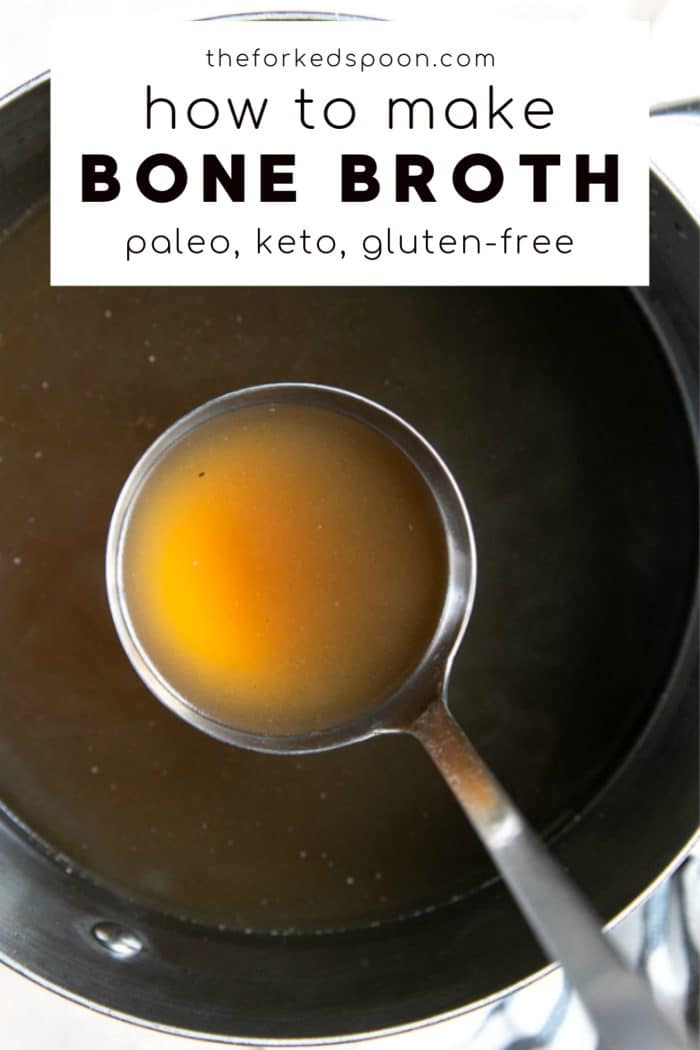
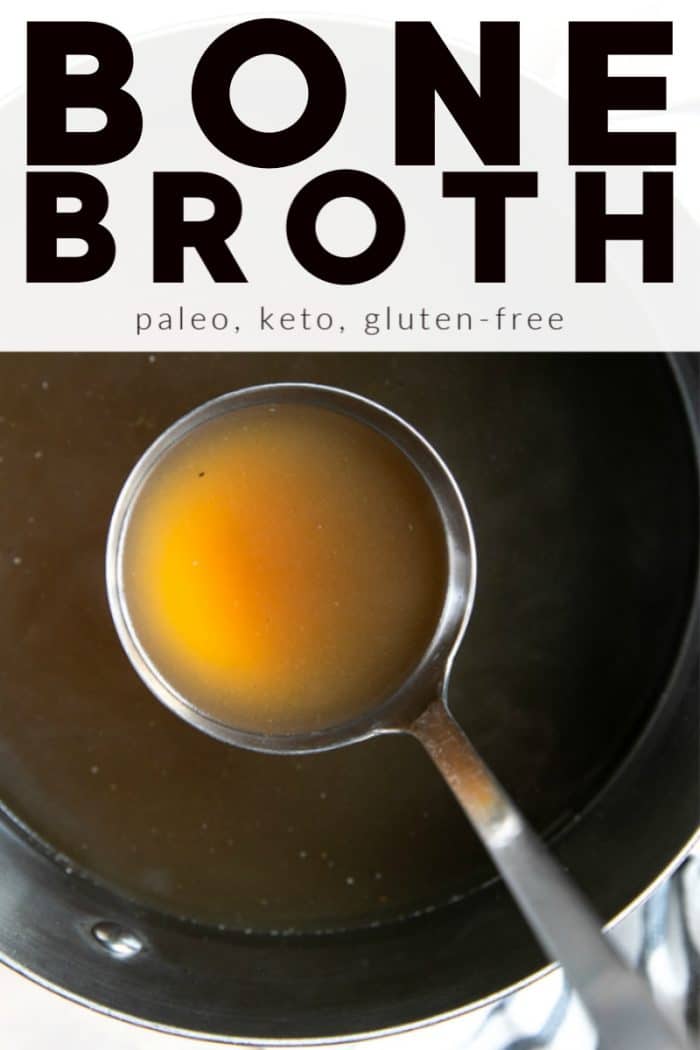
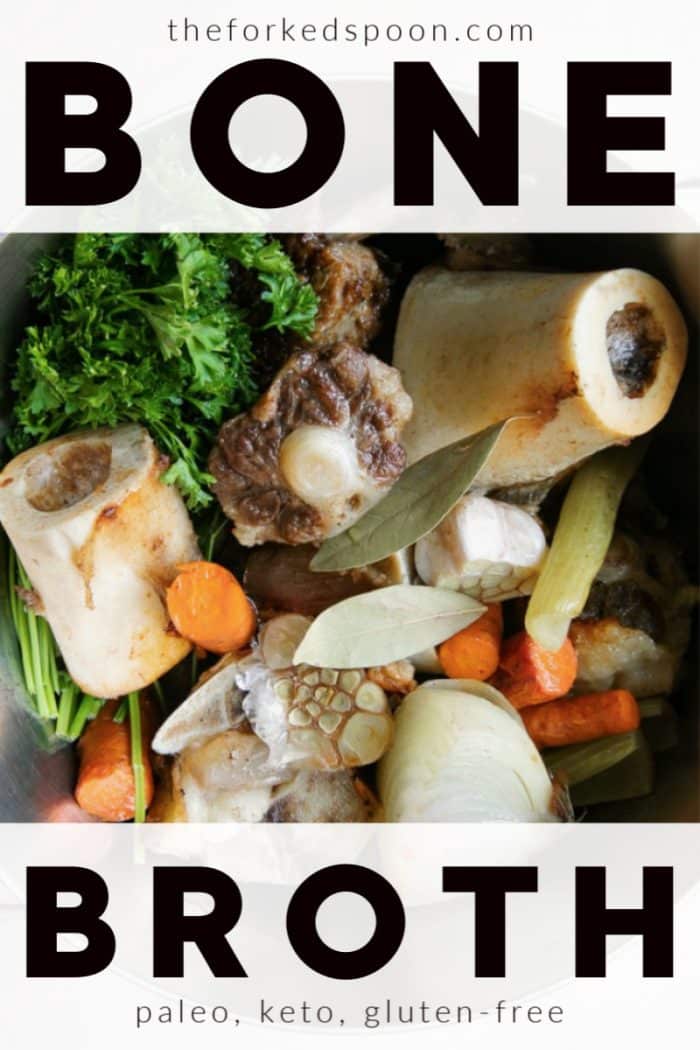
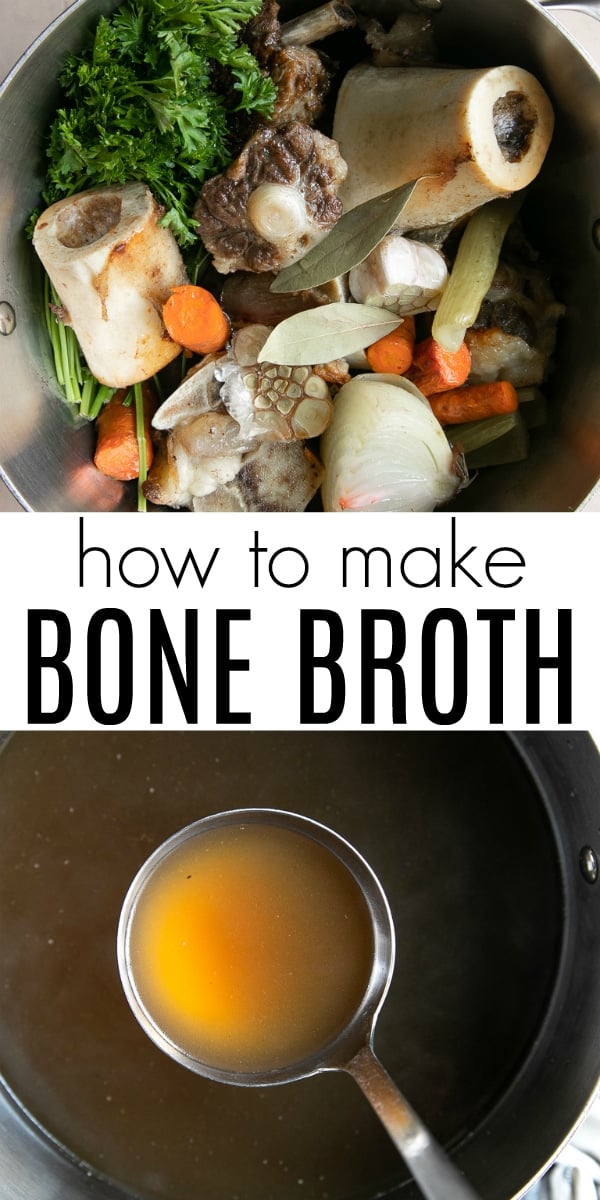

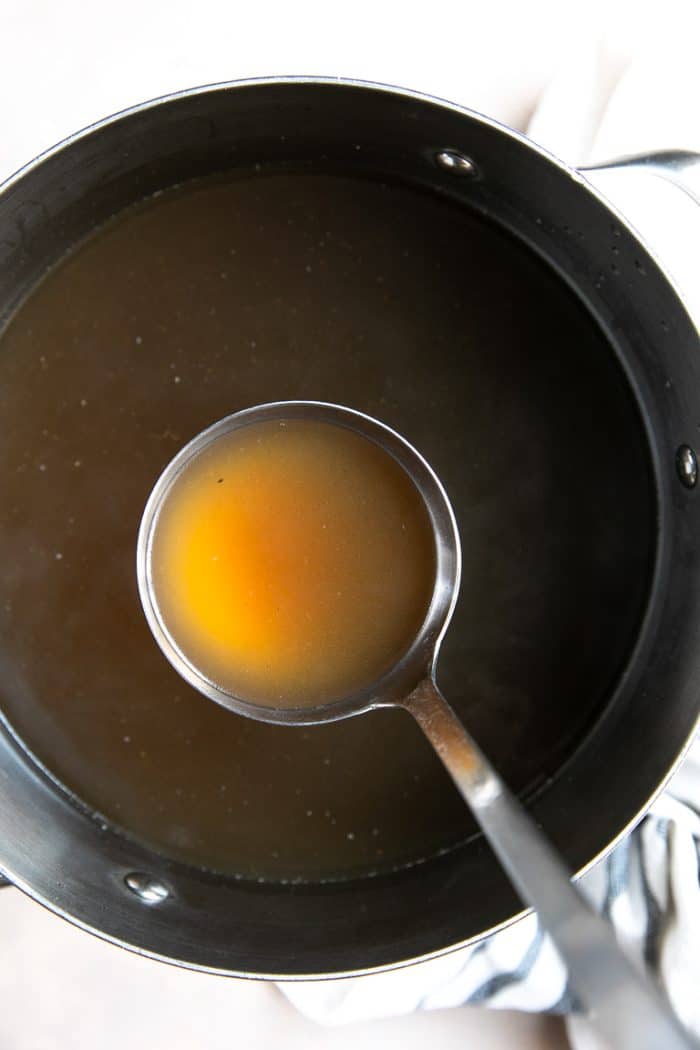

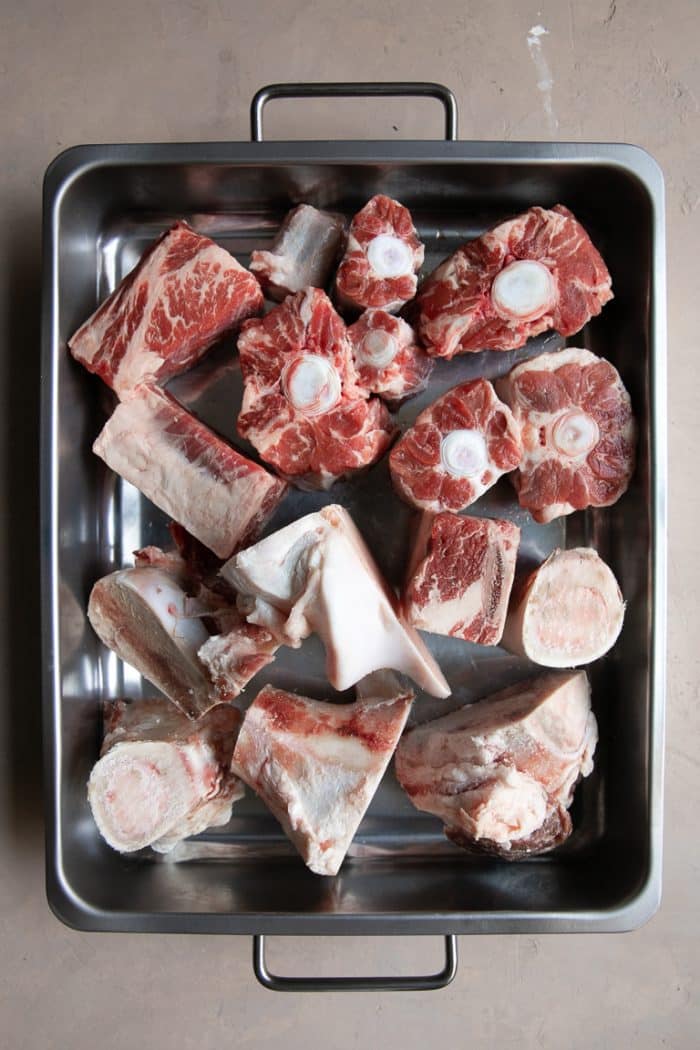
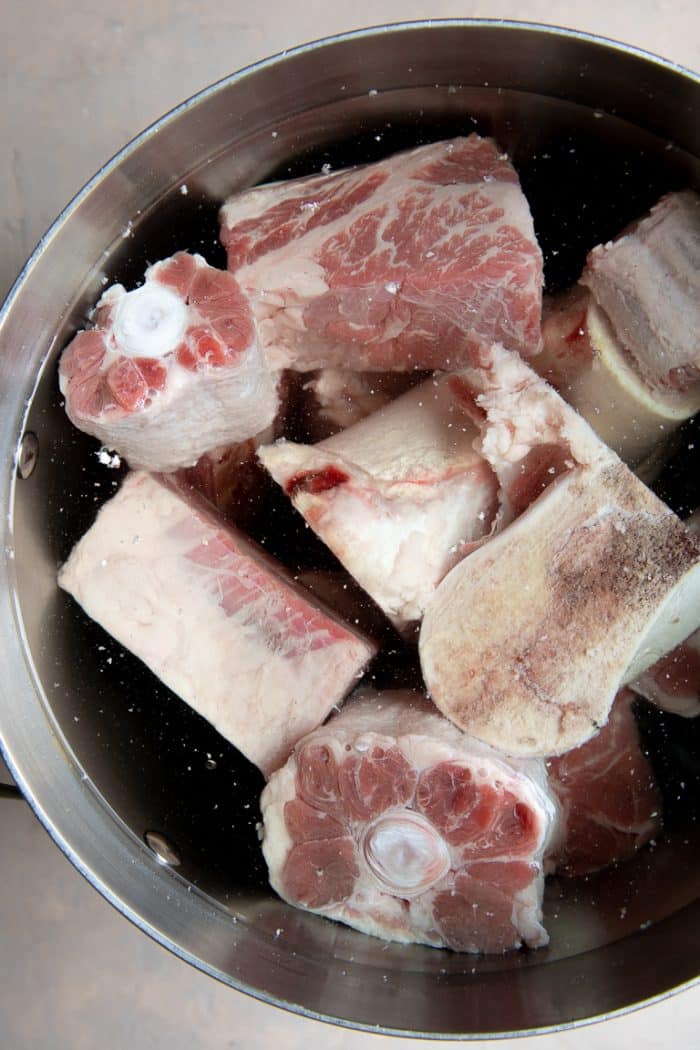
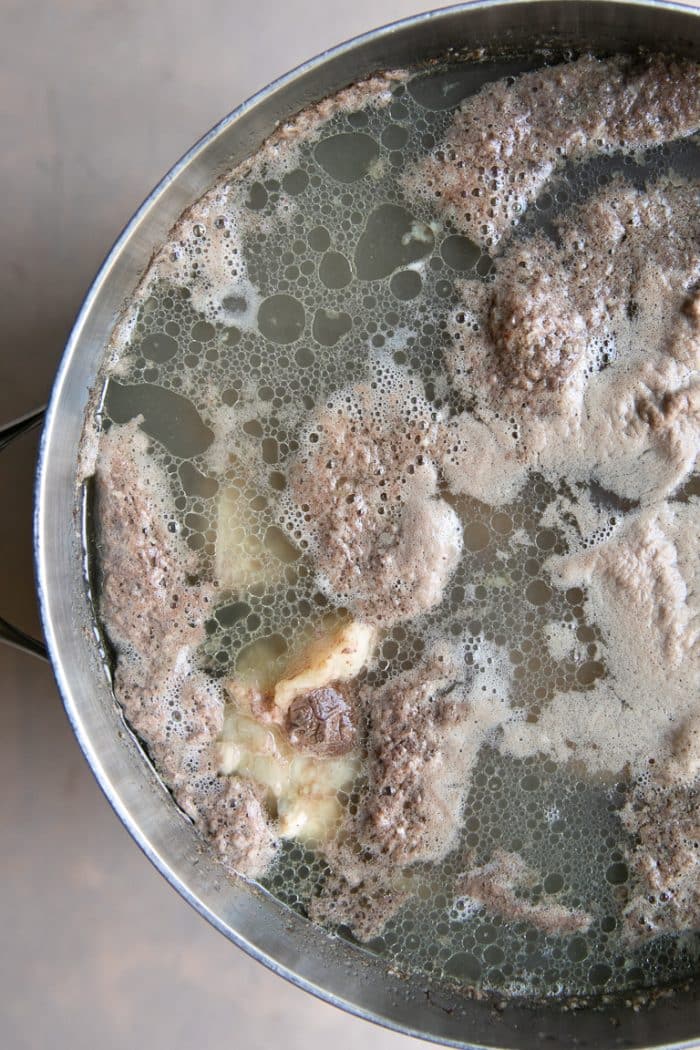
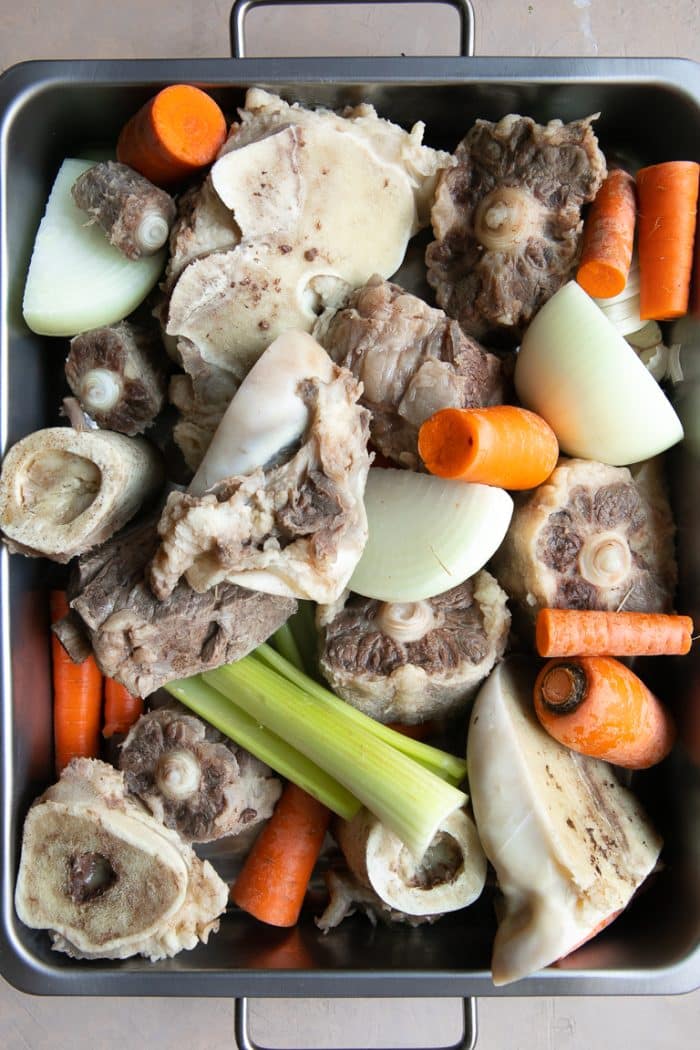
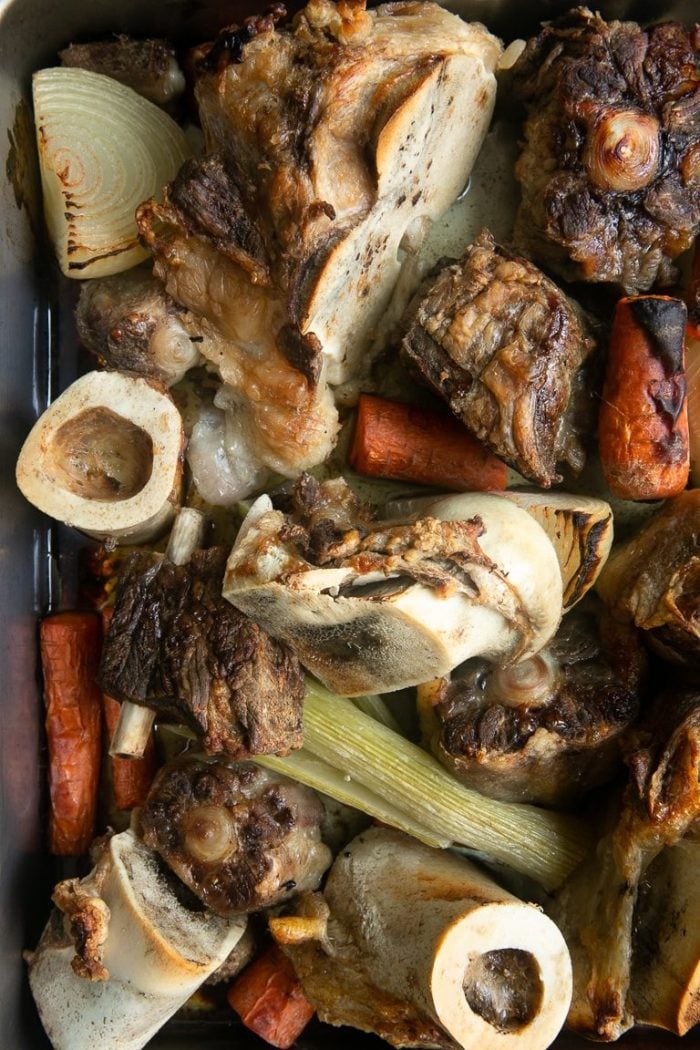
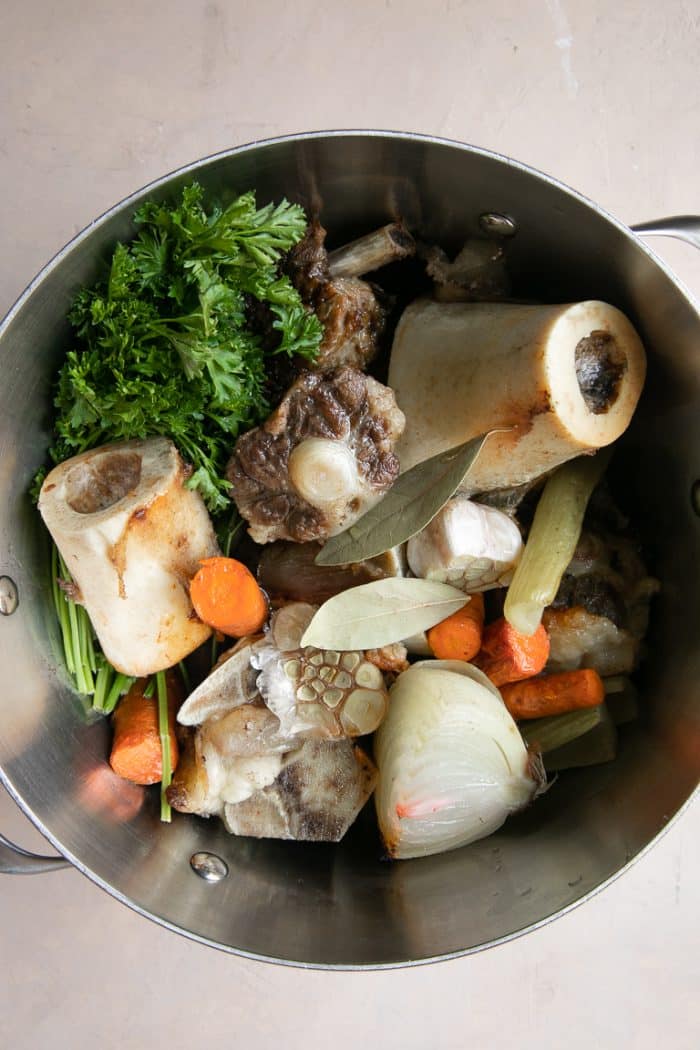
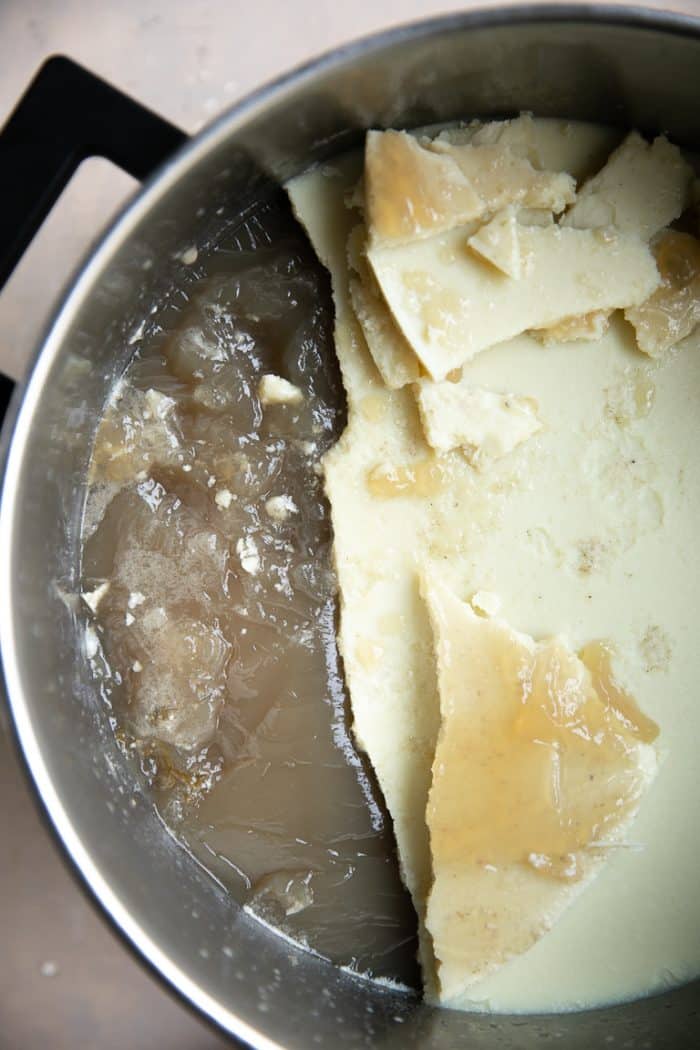
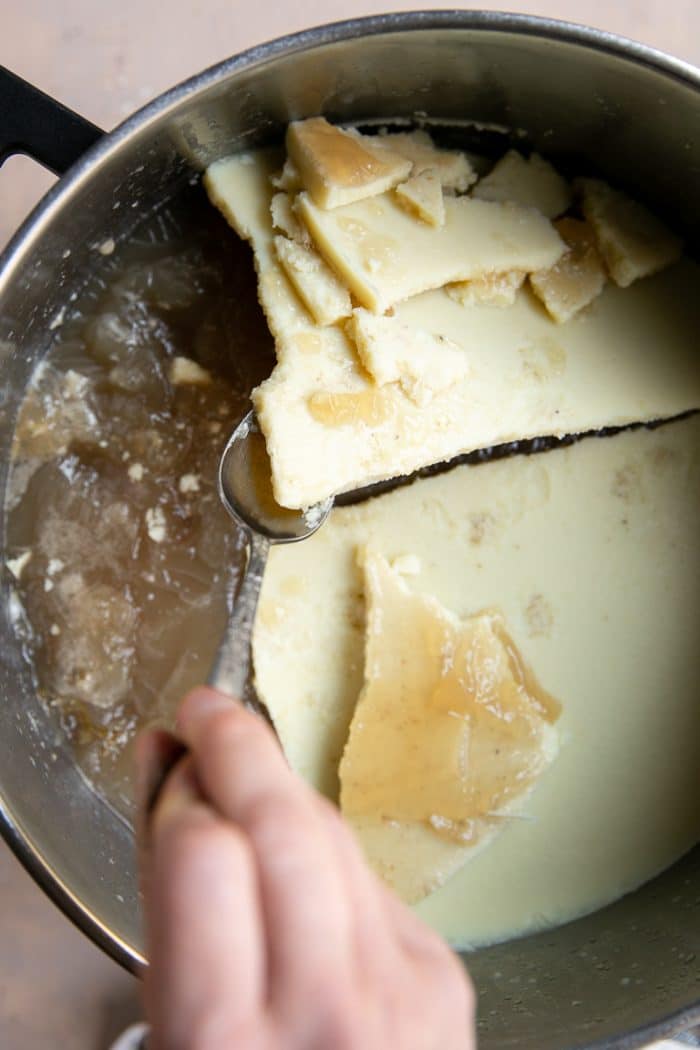
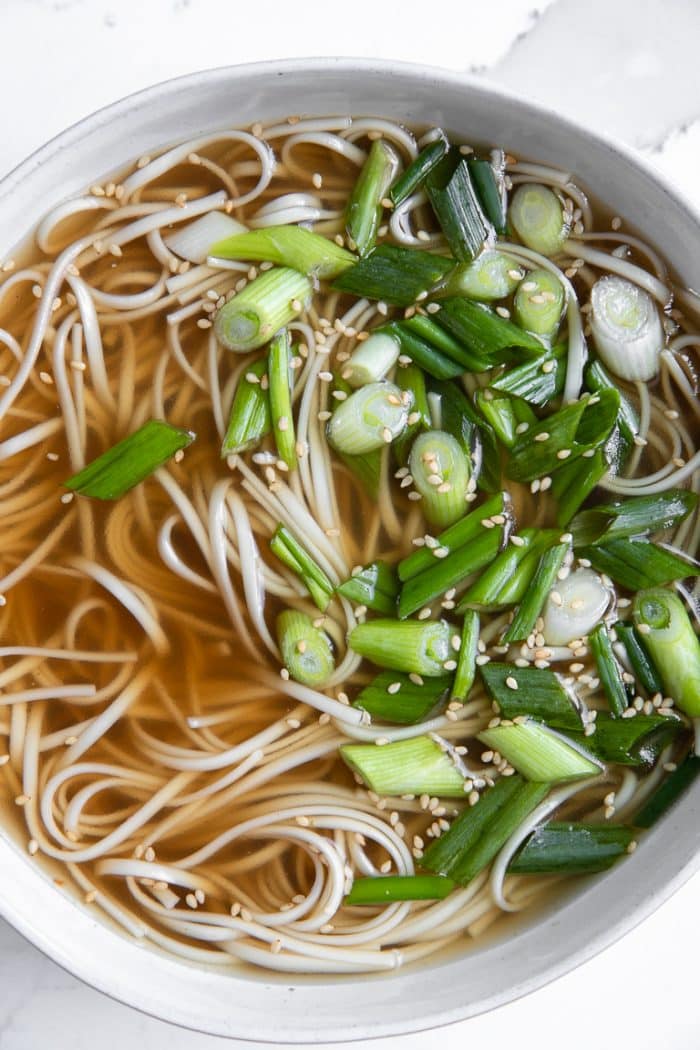


This is a really good stuff! I added some additional celtic salt, and finished steak to make it a hearty and healthy soup. This will be a new staple. Thank you.
I appreciate the feedback and notes, Ben 🙂
Next time I make bone broth I will be leaving out the cinnamon sticks and star anise
I have been simmering for about 15 hours and I am really trying to trust the process but my house smells like Christmas. I followed the instructions for the how much star anise and cinnamon to add but with how strong the smell is, I am very concerned the taste is going to be very overpowering. Does it chill out while simmering and then once you do the fat separation?
It sounds like you’re doing a great job following the recipe! It’s normal for the spices like star anise and cinnamon to give off strong aromas while the broth simmers, especially over many hours. These spices should mellow out as they continue to infuse the broth at a low temperature. Once you complete the simmering process and proceed to remove the fat, you’ll find that the flavors have balanced out. The fat separation step also helps in reducing the intensity of the top notes of the spices, leaving you with a richly flavored but not overpowering broth. If the taste is still stronger than you prefer, consider using less spice in your next batch or diluting the finished broth with a little water.
I don’t usually comment on recipes, but this turned out fantastic! I will definitely make it again but I will probably use half of the peppercorns, as it’s a little peppercorn-y for my Caucasian pallet… but still very delicious!! I followed the recipe exactly and used organic local beef tomahawk ribs and necks from our pet store (huge savings if you can find raw organic bones at your pet store people! don’t sleep on this!), lots of tendons and cartilage on the bones. Because the bones were large, I roasted them on two pans first and then the veggies after. I didn’t get much caramelization on the pan from the bones but lots on the veggies that I used in the broth. I simmered mine for 24 hours and added 1 tsp of Celtic salt. After chilling and skimming the fat, I was left with 5 liters of beautiful, jelly like bone broth. WAY better (and more cost effective) than the store. Thank you so much for your recipe!!
I appreciate your fantastic feedback and tips, Tala 🙂
Hi, can you use pork bones instead of beef?
Absolutely 🙂
Hi Jessica The first time I made this recipe I had the gelatinous end result after removing the ‘softly’ hardened fat, and it was delicious when heated up. I just finished a new batch but I noticed I had a lot more grease, most of which I removed before letting it cool in the fridge. The fat that was at the top was not quite ‘hard’ like the first time and the actual broth was not gelatinous like the first time I made it. I used short ribs, oxtail and store bought soup bones pmts all the ingredients in your recipe. Is us safe to consume the way it came out? Thank you! Olga
Yes, its perfectly safe to eat fat on top, just reheat it and it will blend into the broth again 🙂
Hi! If my butcher did not cut up some of the larger bones, is that okay? I’m assuming they just won’t roast as well/evenly… Also, what’s the best way to reheat broth from the freezer?
For your bone broth, it’s perfectly fine if some of the larger bones weren’t cut up by your butcher. While smaller pieces do roast more evenly and can sometimes release their nutrients more readily, larger bones will still impart plenty of flavor and nutrients; it might just take a little longer to extract all the goodness. Be sure to roast them well to enhance the depth of flavor in your broth.
When it comes to reheating broth from the freezer, the best method is to thaw it slowly and gently. You can move the frozen broth to the refrigerator to thaw overnight. Once it’s thawed, reheat the broth on the stove over low heat to help preserve the flavors and nutrients. Avoid boiling vigorously, as slow and gentle reheating maintains the quality of the broth. This method ensures your broth remains delicious and nutritious.
When I roasted the bones and veggies, I ended up with clear fat and blackish remains in the pan–not the brown I’d hoped for. Should I still transfer that all (fat and black remains — probably over-caramelized sugars from veggies) into the broth pot?
When making bone broth, achieving the right level of caramelization on the bones and vegetables is crucial for developing flavor without introducing any burnt or bitter tastes. In your case, it sounds like the bones and vegetables may have been slightly overcooked during roasting, leading to the blackish remains. Here’s how to proceed:
Assess the Extent of Burning – If the bones themselves are not burnt but just the vegetables and bits on the pan are, you can still use the bones. If the bones and veggies are not burned, but just the blackish remains in the pan, the the bones and veggies are fine to proceed without any of the burnt bits 🙂
Before straining, should I take out all the meat with tongs?
You can if you want. Or you can take the meat off after straining when the bones have cooled.
My doctors, wife, cooks beef bone broth for all of the time, the last time I was in he was telling me how excited she was to have finally gotten a pressure cooker to cook this with. He talked a lot about how many hours it would take her to cook it on the stove she had not tried it yet, but was very excited about doing it in the next few days. I have always used the already cooked product. I had never thought about doing it myself, and I after reading and studying for advice from people who are a perfectionist. I am very excited to try it myself. Are use a lot of it and making a very healthy vegetable soup. I usually make a large batch and when it’s cool, I put it in a container that looks like a large ice tray each section holds a cup when I get ready for a bowl of soup. I just pop one out and put it in the microwave for five minutes. I have a very quick delicious meal that is so healthy. I really hope my first try to be a success. The most important thing to me is knowing where my meat came from so please wish me luck. I don’t think I can fail with all of the good advice that has been given to me through reading all of the wonderful articles. Thank you very much.
If you microwave it you have destroyed all its goodness. Microwaves destroy all the nutrients take the time and heat it on stove.
I was making this and 3 days in burned the heck out of it. 🙁 Going to try again. It smelled amazing.
Freezing in jars: how do you keep the jars from cracking? Am i just putting too much in the jar and then it expands too much during the freezing process?
Freezing bone broth in jars is a convenient way to preserve it for future use while maintaining its nutritional value. Start by allowing the broth to cool completely after cooking. Then, choose appropriate freezer-safe jars, leaving about an inch of space at the top of each jar to allow for expansion as the broth freezes; this helps prevent the jars from cracking. Secure the lids tightly, but not overly so, as the liquid needs some space to expand. Label each jar with the date and contents before placing them in the freezer, ensuring they are upright to avoid any leaks. This method makes it easy to store and thaw the exact amount of broth you need, whether for a warming soup or a flavorful cooking base.
Use mason jars without shoulders, allow plenty of headspace, and allow to cool completely before freezing, and allow to thaw completely before warming.
Hi! For the 10 lbs of beef bones recipe, do i need two pots or will that fit in a 10 qt pot and 10 qt slow cooker?
For 10lbs of beef bones, it will fit into a 10 qt pot and a 10 qt slow cooker 🙂
Thank you! Very Helpful!
Hi, just wondering about salt? Leave it out?
Great recipe! Thanks.
Salt to taste at the end 🙂
Can I use celery leaves instead of the stock?
Absolutely, you can use celery leaves instead of celery stalks in your bone broth recipe. The leaves actually contain a lot of flavor and can add a nice herbal note to the broth. They’re a bit more intense in flavor than the stalks, so you might want to use them in a slightly smaller quantity unless you enjoy a stronger celery taste. Just toss them in with your other ingredients and simmer away. This is a great way to use up all parts of the celery and reduce waste in your kitchen!
Great recipe! The first time I made this the broth came out of the fridge with gelled broth and fat on top. The same thing the second time, but there was also a white gelled layer at the bottom of the pot. I think that it is gelatin that didn’t get absorbed to the broth because the broth was saturated with collagen. Is that what it is? If so, how should I use it? Thanks!
The cloudy white layer you observed at the bottom of your pot after making bone broth is indeed likely to be gelatin, which forms when the collagen from the bones, connective tissues, and joints is broken down during the slow cooking process. This gelatin is a sign of a rich, nutritious broth, as it indicates a high content of collagen, minerals, and amino acids that have leached from the bones into the broth.
Gelatin is not only beneficial for gut health and joint health but also contributes to the broth’s body and mouthfeel, making it more substantial and satisfying to consume. When you reheat the broth, the gelatin will dissolve back into the liquid, giving it a smooth and silky texture.
To make use of this gelatin-rich layer, simply stir the broth before serving or reheating to reincorporate the gelatin into the liquid. You can use this nutrient-dense bone broth as a base for soups and stews, a cooking liquid for grains like rice or quinoa, or sip it on its own as a warm, comforting beverage. If you’re preparing dishes that benefit from a thicker, more velvety texture, such as gravies or sauces, this gelatinous broth will be especially valuable. Enjoy the added richness and depth of flavor it brings to your cooking, along with its health benefits.
Oh my gosh I was wondering what that was. I did this with turkey instead of beef and it is AMAZING! I canned it but wasn’t sure what was happening to it as I didn’t think it was fat, but gelatin makes so much more sense! Did you know that gelatin and collagen both share the same 19 amino acids. Yippie for me. I was eating it, it tasted good but didn’t know what it was. THANK YOU!
I love it on my rice and just about anything I cook that calls for water!